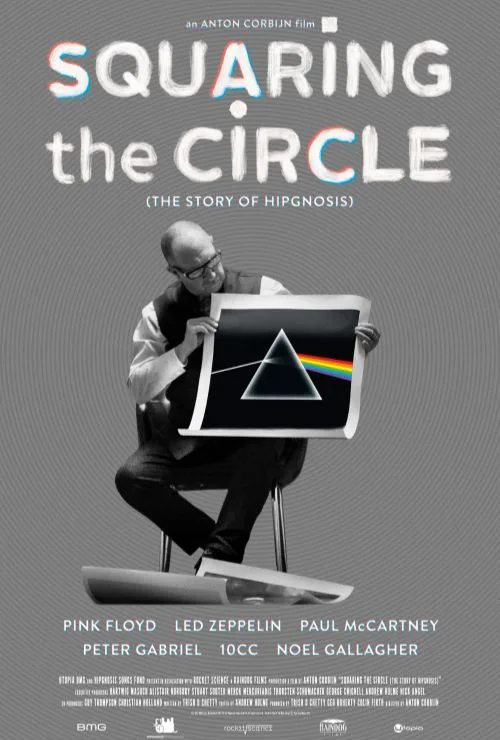Reviewing the Pink Floyd album Wish You Were Here in 1975, critic Robert Christgau concluded his praise of the record (he gave it an “A-,” the highest grade he’d ever give the band) by declaring, “And the cover/liner art is worthy of all the stoned raps it has no doubt already inspired.”
That cover/liner art was a multi-leveled thing. First of all, in the days when “albums” were presented on twelve-inch slabs of vinyl as a matter of course, if not default (Wish You Were Here was very big on 8-track too), Pink Floyd’s long-awaited follow-up to Dark Side of the Moon came shrink-wrapped in opaque plastic, kind of deep puke green in color. There was a little sticker attached to the top corner of the shrink wrap with the band’s name and the album’s name in a circle, in the center of which was a sci-fi graphic of a robot handshake. Some record collectors never removed the shrink wrap from the album, merely slitting it open on the side where the sleeve containing the vinyl was.
As one figure in this documentary directed by Anton Corbijn notes, doing this, in a sense, rendered the album title almost literal. If you did take off the shrink wrap, the cover image, a photograph on what looked like a Hollywood studio backlot (because it was) depicting two men shaking hands, greeted you. One of the men was on fire. A postcard inside the sleeve showed a pair of legs sticking out of a body of water as if capturing a perfect dive at a high shutter speed. But, of course, it was a stunt swimmer standing on his head underwater. The photographer, Aubrey “Po” Powell, recalls that he still gets goosebumps thinking of taking that shot.
Powell co-founded Hipgnosis, the design firm that defined and redefined album cover art from the psychedelic sixties through more indulgent and decadent times. Its other founder, Storm Thorgerson, who died in 2013, was the subject of a 2011 documentary called “Taken By Storm,” which I haven’t seen. But this account, while at a disadvantage due to Thorgerson’s absence, has a leg up due to director Corbijn’s keen sense of visual pertinence—prior to becoming a film director, he was a rock photographer of high distinction—and his professional connections, which likely enabled him to get fresh interviews not just with the Pink Floyd members who were in the prior documentary, but additional heavy hitters like Paul McCartney, Robert Plant, Noel Gallagher (not a Hipgnosis client, but here fulfilling the role usually played by Bono in such docs, that is, “Mr. Contemporary Context”) and more.
Shot in the black and white that Corbijn favors in his still photography (and which he used for his debut feature “Control,” about the doomed Joy Division singer Ian Curtis), except, of course, when it breaks out the dazzling color work done by Hipgnosis itself, “Squaring the Circle” makes the still-living Powell its focus and fulcrum. He first appears with a giant Hipgnosis portfolio tied to his back by a rope—his legacy and the weight he’s gonna carry a long time. He tells the story in personal terms. Moving to London in his late teens, he’s attracted to a house nearby where the people drifting in and out are the most interesting that he’s ever seen. Eventually, he gets the gumption to go in. It’s a crash pad, and among the crashers are Syd Barrett and Roger Waters and Storm Thorgerson. Mostly they’re sitting around getting stoned and listening to jazz records. But soon, they set about creating. Syd and Roger form Pink Floyd. Storm and “Po” study fine art and photography at the Royal Academy. The musical friends ask the graphic friends to concoct artwork for an album cover. Influenced by pop art and psychedelics, the duo put together the cover for Floyd’s second album, A Saucerful of Secrets.
They take their name from something someone spraypainted on the door of the crash pad. “Hip,” that means hip. “Gnosis,” that’s knowledge. Hipgnosis. Groovy. Who painted it on the door? In classic “if you lived through the sixties, you don’t remember it” fashion, recollections differ. Some say Barrett. Some say a person less famous. Some say a person less famous than that.
Powell recounts how LSD caused some casualties, including Barrett. An interesting irony about Wish You Were Here is that a discombobulated, bald, overweight Syd Barrett showed up at Abbey Road studios while the band was recording this homage to Syd and elegy for the sixties that Syd helped define, for better or worse. We learn here that before going to the studio, Barrett showed up at the Hipgnosis office, asking for his old mate Storm. He was directed to the recording studio, where Storm, a ferocious idea man, was watching the proceedings and brainstorming so to speak.
“He was a man who could not take yes for an answer,” one interviewee says of Thorgerson. Powell is visually shaken, silent, and tearful when discussing the business rift that estranged him and Thorgerson for over a decade starting in 1980. He says that just as huge financial success sowed seeds of discord in Pink Floyd that today still resonates in the sniping that goes on between Roger Waters and David Gilmour, so too did the size and cultural impact of Hipgnosis make the already rocky—but always respectful and affectionate—personal relationship between the founders untenable. Before the heartbreak, there are outlandish and often funny stories about iconic album covers. (As in deep background on the stunt person who got set on fire for the Wish You Were Here cover.) And, if you’re interested, there’s a glimpse of the softer side of the quarrelsome Roger Waters, who at one point frankly and tenderly says, “I loved Storm. I still love Storm.” Shine on, as the saying goes.
Now playing in theaters.




















